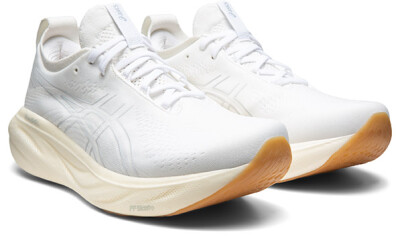Over recent years, the focus on sustainability has intensified in the running marketplace. It’s showcased today in apparel and socks crafted from sustainable materials and more environmentally friendly packaging for nutrition products.
Creating more sustainable running footwear, however, has proven to be a more complex challenge. Ethylene-vinyl acetate (EVA) and thermoplastic polyurethane (TPU), after all, have long been essential ingredients to running shoes and neither is particularly environmentally friendly.
Increasingly, though, footwear brands – from established players to up-and-coming challenger brands – are cracking the code and creating more sustainable footwear. Running Insight highlights a few notable efforts in 2023.
ASICS Nimbus 25
ASICS continues pushing toward a net-zero future and the brand’s product team has embraced sustainability as one of its pillars of innovation. It’s an effort reflected in the Nimbus 25 released earlier this year.
Notably, ASICS evolved its BLAST+ midsole foam into BLAST+ ECO. While retaining the same experiential and performance properties as BLAST+, the eco-friendly version features 20 percent bio content from sugarcane waste to reduce environmental impact.
In addition, the Nimbus 25 climbs over the 90 percent mark in recycled polyester material by weight, a significant step in reducing the company’s reliance on virgin materials and moving closer to circularity. ASICS also investigated ways to directly reduce emissions in its manufacturing processes, which resulted in using a sockliner sustainable dying process that reduces emissions by about 45 percent.
“Our mantra is a lighter footprint for a brighter tomorrow and [the Nimbus 25] is a great example of this coming to life,” ASICS senior manager of merchandising Paul Lang says.
Topo Ultraventure 3 ECO
Next month, Topo will introduce its most eco-friendly product to date: the limited-edition Ultraventure 3 ECO. The high-cushioned trail shoe features an engineered mesh upper made with 65 percent recycled polyester and a polyurethane print incorporating recycled content. The midsole is comprised of 15 percent recycled foam, while the Vibram Ecostep outsole uses 30 percent recycled Vibram rubber.
“The Ultraventure 3 ECO was a collaborative effort across the product, development, design and marketing teams as well as our component suppliers like Vibram and Ortholite,” Topo product manager Russ Stevens says. “Everyone embraced the idea of creating a more sustainable product and brought ideas to the table on how we could bring that vision to life.”
Stevens calls the Ultraventure 3, one of Topo’s most popular trail shoes, the logical starting place for Topo’s “Eco” program investigating the use of new, more sustainable materials and processes — an endeavor that will inform the sustainable design of future Topo product.
“The Eco program will help all of our products become more sustainable to protect and preserve natural spaces,” Stevens says.
Salomon INDEX.02
In March, Salomon introduced the INDEX.02, the second iteration of the innovative recyclable running shoe the French brand first launched two years ago.
A yellow “splitting” line on the INDEX.02 visually separates the shoe’s two materials: the bottom being a fully recyclable TPU foam called Infiniride and the higher section being polyester or recycled polyester, explains Olivier Mouzin, footwear sustainability manager at Salomon.
To streamline recycling, Salomon places a QR code on the tongue of one shoe. Owners can scan this code and register their INDEX.02 upon purchase to propel its eventual return to Europe for recycling at end of life. Salomon’s plan is to recycle the shoe’s individual parts and incorporate the materials into the construction of new alpine ski boots.
“Our main issue right now is really to educate consumers to send back the products,” Mouzin says, hopeful that a more developed and known process will fuel Salomon’s efforts around sustainability.
Scarpa Spin Planet
While Scarpa, the Italian mountain company making strong inroads into the trail running market, aims to build sustainability into as many products as it can, Scarpa North America VP–sales Mark Mathews acknowledges niche or specialized shoes typically appeal to a smaller audience. In creating the sustainability-minded Spin Planet, however, Scarpa employed the opposite approach: it ventured to build a great all-around trail shoe that would “appeal to the majority of trail runners and, thus, maximize the sustainable impact,” Mathews reports.
“We are really excited with the results,” Mathews confirms.
Launching this spring, the Spin Planet features a breathable upper made with 100 percent recycled content, a high-volume cushioned midsole with 45 percent recycled content and a PRESA outsole comprised of 30 percent recycled rubber. Scarpa is billing the Spin Planet as a high-quality trail running shoe that allows runners to be “light on [their] feet and light on the planet.”
Brooks Catamount 2
With its recently released Catamount 2, Brooks takes another step toward its ambitious goal of net-zero carbon emissions by 2040. In total, the updated Catamount uses 16 percent recycled material.
The $170 “ultra trail shoe” features Brooks’ first rubber outsole containing recycled content. The TrailTack outsole is made of 25 percent recycled silica from the semiconductor industry.
The Catamount 2 also sports a dope-dyed and recycled sockliner top cloth made of 100 percent recycled plastic water bottles. Dope dyeing – a technique in which the pellets of raw materials are dyed before being extruded and spun into yarn – generates 92 percent fewer greenhouse gas emissions and uses 94 percent less water than conventional dyeing.
In addition, the Catamount 2 boasts 75 percent recycled textiles, including a tongue and gusset made with 100 percent recycled polyester, and 40 percent recycled materials in the upper. The nylon rockplate is comprised of 77 percent bio-based nylon, while the toe box and heel counter plastics are also made with recycled content.







